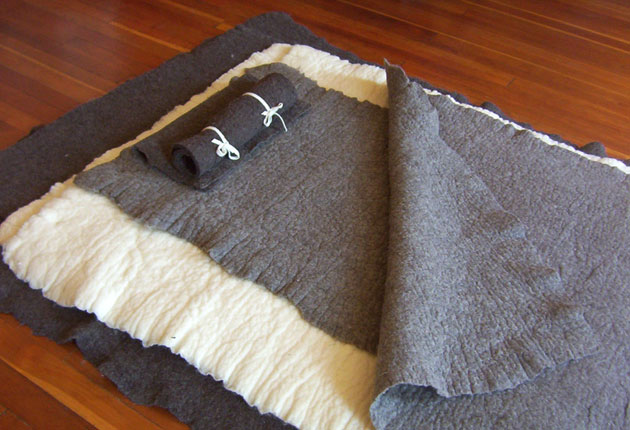
As anyone with a serious chronic illness knows, one’s bed is an important place for deep healing to occur. When challenged with severe chemical sensitivities, bed frames, mattresses, sheets and bedding can become huge obstacles between you and a night of stress-free, rejuvenating sleep.
Bedding has been a particularly difficult mystery to solve for myself since I developed severe Multiple Chemical Sensitivity (MCS) in 2004. For much of the past five years, I have slept on cold, hard wood or tile floors with minimal (and now, no) bedding except for a pillow, and usually without a source of heat except, if I’m lucky, a small hot water bottle. I cannot tolerate organic cotton, wool, silk, synthetics, and almost any type of material on my body; this includes clothing as well. In the past I have sometimes done okay with regular cotton items that have been well offgassed, but this is rare. The problem is potentially life threatening, as I am poorly equipped for low temperatures and am concerned about the impending winter and near-zero degrees it will bring.
For this reason, I wanted to survey the MCS community to see how others had creatively solved this problem. I hope this small collection of inspired solutions will give you hope and direction, as it has me.
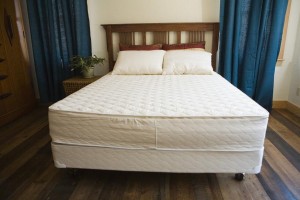
Chemical free mattress
Conventional mattresses are fairly toxic and may contain harmful chemicals such as formaldehyde, toluene di-isocyanate (TDI), styrene, butadiene, and other petroleum derivatives, in addition to flame retardants like antimony and silicon—not really substances you want to be breathing in all night and absorbing through your skin, especially if you have MCS.
The main objective for most sufferers of chemical sensitivity when shopping for mattresses and bedding is to find materials that are non-toxic (chemical-free), comfortable, supportive, durable, and affordable. Depending on your individual tolerances, that means buying a futon or mattress made with any combination of organic cotton, wool, latex, hemp, and other natural materials. There are many companies selling quality bedding nowadays, and the one thing they will have in common is to require a doctor’s prescription if indeed the mattress is chemical free since current law requires flame retardants in all mattresses unless you have a medical exemption. An exception are wool mattresses since wool is naturally flame-resistant and can pass strict flammability tests.
Mattress and bedding companies recommended by those with environmental illness include: Furnature, Green Nest, Heart of Vermont, Janice’s, Lifekind, Natura, Royal-Pedic, Savvy Rest, Soaring Heart, The Clean Bedroom, and Tomorrow’s World.
Of course, one needs to do their due diligence when choosing any product by speaking with the company to find out any materials and chemicals used in the manufacturing process, inquiring about pesticide spraying in the storage facility, getting their return policy in writing, asking if they can send material samples, etc. Do not assume anything even when a company seems reputable and has been recommended by another EI; even if the company is sustainable and health-conscious that does not mean they understand MCS, or specifically your unique version of the illness, as we all have different triggers and levels of reactivity. Even if the company’s website has a section devoted to MCS, we still recommend basing your decision on material samples and your own body wisdom. Don’t let someone on the other end of a phone convince you that their product is safe for MCS, because really no product is and can never be — MCS does not have a uniform trigger/symptom set.
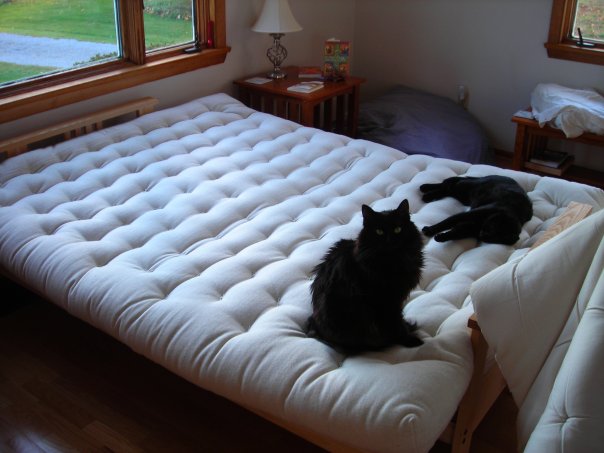
Full wool bed system
Jacki in Ohio loves her wool mattress from Shepherd’s Dream—and so do her cats. Shepherd’s Dream, a green company operating out of California, believes that wool is the ideal fiber for bedding because it is naturally breathable, hypo-allergenic, dust-mite, mold and mildew resistant, easy to care for, and the protective lanolin coating found in wool makes it naturally resistant to combustion so it is able to pass strict flame tests with no chemical treatment. Jacki purchased her wool mattress, wool Snuggle Mate, and wool topper in November 2007 and still feels like she’s “sleeping on a cloud.” Another big fan of Shepherd’s Dream is Debra Lynn Dadd, The “Queen of Green.” She writes about their sustainability mission and shares the wool products she uses on her own bed on her site.
From Shepherd’s Dream’s website:
“Through the years, we have found that wool is the ideal material for the sleeping body. Wool has the ability to keep your body in its optimal comfort zone so that one never feels too hot or too cold. It naturally calms the nerves and lowers the heart rate helping one to sleep deeply without tossing and turning. People have been amazed by wool’s natural ability to relieve arthritis pains, rheumatism and every day back pains. Our wool bed system provides a breathable sleep environment that will support your natural alignment and help to relieve painful pressure points.“
They also have a section devoted to chemical sensitivity where they recommend those with chemical sensitivity start with a free test kit to sample swatches of the 3-5 different types of materials used in their bedding.
A word of warning: I purchased a Shepherd’s Dream wool comforter right before I was diagnosed with MCS. I had it for a month and loved it so much, I went ahead and invested in a mattress topper and pillows as well. The first night I slept in the fully-outfitted bed, I sensitized to the wool and had to remove all the bedding from my apartment. After that, I could not tolerate wool clothing that I had worn previously. The products were not returnable. There is certainly no way to know ahead of time if one will sensitize to a substance over time. But looking back, I don’t think I aired out the bedding or washed it before putting it on my bed; a no-brainer to a veteran MCSer but to the uninitiated, off-gassing is an unknown concept. I would recommend you air out any new bedding and wash it if possible to get it as neutral as you can before using it on your bed.

Layers of wool felt fabric
Eliana Jantz of Shepherd’s Dream recommends using wool felts that can be layered for a bed and easily aired out in the sun without having to lug a heavy mattress outdoors. They can also be machine-washed on a delicate cycle. However, they do shed. For those not allergic to wool, these are a cheaper alternative to a full Shepherd’s Dream wool bedding system. Two sources we like are nearseanaturals.com and shepherdsdream.com, but you can buy them at any reputable supplier of chemical free wool fabric. photo: © Eliana Jantz / Shepherd’s Dream
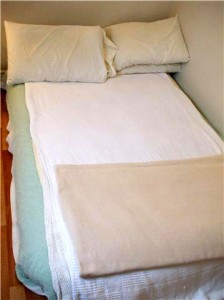
Make your own
Lisa in Nova Scotia, Canada writes:
“I had a wooden futon frame (made of beech and offgassed for about 9 years) and then I stretched a large piece of unbleached cotton canvas (that had been washed many, many times) over the frame and affixed it with upholstery tacks on the sides. This helped so that the blankets I placed on top would not fall through the slats. Then I put piles of cotton blankets on top of the canvas. I stretched a fitted sheet over all the blankets. Then I put my regular sheets over this and then blankets on top. It is so amazing to sleep in a bed after sleeping on hard floors for almost 10 years.“
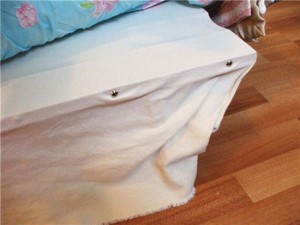
You can see in the photo on the right Lisa’s futon frame with canvas stretched over it and fastened with upholstery tacks. She then put many layers of blankets to form a mattress.
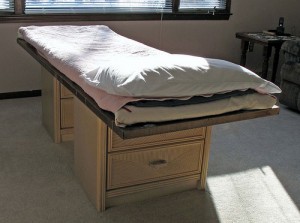
If you need to get off the floor, you could try one woman’s creative approach and put a well-offgassed door on top of two dressers. Don’t forget to remove the door knob. Then layer with a camping mat, old cotton blankets, or whatever tolerable materials you have.
photo: http://www.flickr.com/photos/flahertyb/ / CC BY-NC 2.0
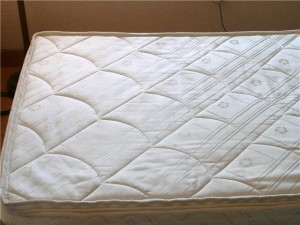
Modify your mattress
Scott in Arizona purchased his Strobel mattress online from PrescriptionBeds.com. Like the name implies, he needed to have a doctor’s prescription in order to buy it. The type Scott bought has an innerspring mattress with a layer of foam on top of the springs, which he replaced with Warm & Natural cotton batting that had been washed and offgassed for many months beforehand. He says, “One nice thing about these mattresses is that they have a zipper that allows you to remove the foam. Many beds are sewn shut.”
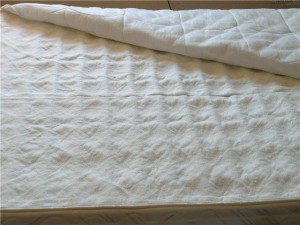
Scott offgassed the mattress for about 7 months and was then able to use it. See the mattress, above right, and the cotton batting in the interior, left.

Another option is to buy just the mattress springs (or take an existing mattress and strip it down). Wash the springs well with Everclear alcohol to remove any machine oil residues. Keep in mind that the metal will rust if you try to wash it with soap and water so it needs to be dried immediately either manually or in the hot sun. Layer tolerable bedding on top of the springs. One EI couple I know placed flat plastic shelving on the mattress springs then layered with thick cotton blankets to create a sturdier surface that also had some plushness to it.
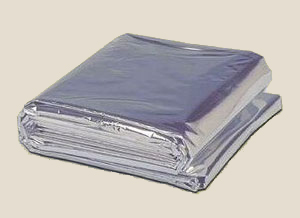
Wrap your mattress
A few friends have had good success wrapping their mattress with various materials. Tu Tuff plastic wrap is one that was reported to me by another EI to be “amazingly unscented” and provide a complete vapor barrier. Other friends have recommended using mylar “emergency” blankets to wrap a mattress with. Be aware that the emergency blankets sometimes have an oily residue on them that you might want to wipe off before using.
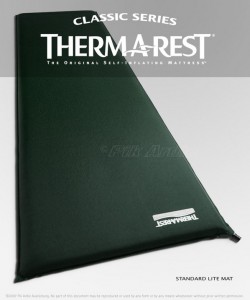
Camping pads
Some EIs who are sleeping on the floor do well with camping pads such as the Thermarest self-inflating foam mat with nylon cover. After purchasing it, you unroll it and let it self-inflate for a day with the valve open. You can then blow into it like a balloon if you’d like it to be firmer. For extra comfort, you can velcro several extra-large mats together (buy the velcro strips at Staples) so they don’t slide around. Because the cover is nylon, you can wash it down easily, and you should not have any mold, mite, or dust issues.
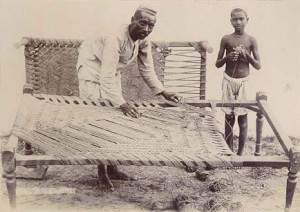
Charpoy (also called Charpoi, Manjaa)
Manjaa is the traditional Punjabi name for a woven bed. The British refer to it as a Charpoy. What was once a skilled craft found in India — with beds typically made using a simple wood frame and cotton rope which is expertly woven and stretched taut across the frame — you can now find companies manufacturing modern versions with various materials in England and other places. Due to my chronic troubles finding a surface to sleep on, a friend had suggested this to me as a possible solution and I spent some time searching for charpoy craftspeople from India in the U.S. or even companies that could make it for me, to no avail. It seemed way too difficult to do myself.
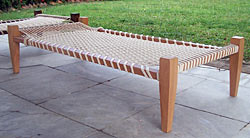
Then eventually I found the String Bed Company in England. They offered to make their wood frame out of metal, and to substitute their nylon cord with a cord of my choosing — I could even purchase an organic cotton cord, boil it, wash it, off-gas it, whatever I wanted, and then send it to them to use for the bed. However, the company manufactures its charpoys in Malaysia, not England. Due to the heavy pesticiding of pallets at Asian ports, I opted not to pursue this option. If you have access to a skilled charpoy weaver, or can think up a unique variation that would work for you, I’d love to hear about the process and see your results.

Hammocks
When I realized how complicated making a charpoy would be, I switched to the idea of a hammock. I searched for an organic cotton canvas hammock and metal stand. I found the hammock on sale at Target and it is offgassing outdoors but it is still highly doubtful that I will be able to use it, as it is made of organic cotton which I do not tolerate and will most likely become moldy before its offgassed enough to be tolerable. I also found this polyester hammock with metal frame (see photo, right) after I had already purchased the organic cotton hammock. It looks interesting however it is not clear if it is made in the U.S. or imported (and possibly sprayed wtih pesticides) and the material is questionable as well. But the frame is powder-coated and it might be easy enough to remove the existing polyester material and replace with something tolerable. This may be a good option that might work for some of you.
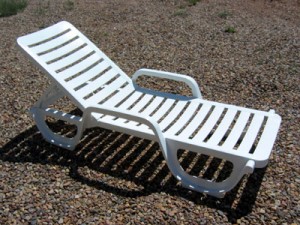
Outdoor Chaise Lounge
I currently sleep on an old plastic outdoor chair that is about 19 years old — it was my landlord’s but he has since given it to me since its the only thing I tolerate. It reclines, but not all the way and so it is very uncomfortable and bad for my posture. I raise my feet on a small metal table that is almost the same height as my chair. Right now I have no other options that I tolerate, but I crave for a flat surface.
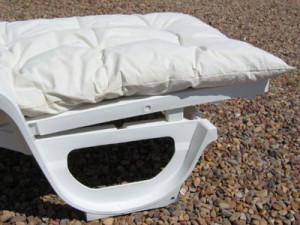
Given my success with this chair, I searched for hours and hours to find an affordable outdoor chaise lounge made from a similar hard plastic, able to lay flat, without rubber wheels or other potentially toxic parts, and comfortable enough to lay on without any bedding to soften the surface. It was hard to find! I finally found a brand that seemed to fit the bill but I am still offgassing the chair and will most likely need to continue for over a year, as I cannot breathe if I bring it indoors, even after several washings and over 6 months of offgassing. I am also hoping and praying I can use a natural cotton exercise mat purchased over 1.5 years ago from Janice’s with the chaise lounge. Fingers crossed…
Outdoor Furniture
While searching for an outdoor chaise lounge, I was simultaneously looking for any type of outdoor furniture made of hard plastic that could be used as a bed. I found a high-end hospitality furniture salon in Miami (see lifeshopcollection.com) that had an interesting assortment of nest-like beds as well as some simple platforms (see photo, above). From ~$1K-3K each, however, it was ultimately out of my price range. I attempted to get a grant to pay for it, but was unable. The beds came in a variety of plastic weaves and colors. The company sent me some samples of the plastic that were too small to really test, but they were willing to modify the beds in any way I needed (for a price, of course) such as raising it off the ground. I am including this option in case someone is really desperate for a hard plastic bed, thinks this might work, and has the money to purchase one at this price. Not sure how comfortable they would be to sleep on without a mattress, but they sure look cozy! I also don’t know how long they would take to off-gas, or if they would ever be tolerable at all. But, ahh, to have a nest of my own…
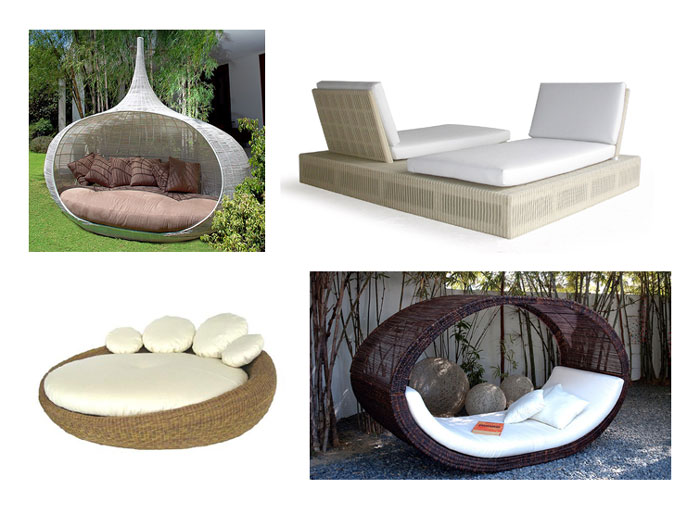
Note: A great article with more bedding ideas can be found on eiwellspring.org: A Safe Bed to Sleep In by J. Camphill.
disclaimer: There is, of course, no guarantee that any of the above solutions will work for you. Please test all materials and use your firsthand body wisdom to determine if an option is appropriate for your situation.







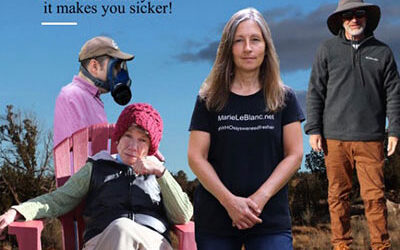

0 Comments